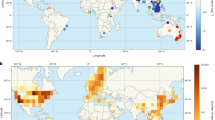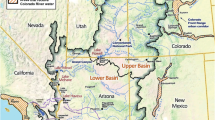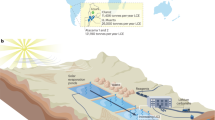Abstract
Background
The Integrated Exposure Uptake Biokinetic Model for Lead in Children (IEUBK model) was developed by the U.S. Environmental Protection Agency to support assessments of health risks to children from exposures to lead (Pb).
Objective
This study evaluated performance of IEUBK model (v2.0) as it would be typically applied at Superfund sites to predict blood Pb levels (BLLs) in populations of children.
Methods
The model was evaluated by comparing model predictions of BLLs to 1144 observed BLLs in a population of children at the Bunker Hill Superfund Site for which there were paired estimates of environmental Pb concentrations.
Results
Predicted population geometric mean (GM) BLLs (GM: 3.4 µg/dL, 95% CI: 3.3, 3.5) were within 0.3 µg/dL of observed (GM: 3.6 µg/dL, 95% CI: 3.5, 3.8). The model predicted the observed age trend in GM BLLs and explained ~90% of the variance in the observed age-stratified GM BLLs. The mean predicted probability of exceeding 5 µg/dL (P5) was 27% (95% CI: 24, 29) and observed P5 was 32% (95% CI: 29, 35), a difference of 5%. Differences between geographic area stratified mean P5 (predicted minus observed) ranged from −11 to 14% (mean difference: 2.3%).
Significance
Although the more general applicability of these findings to other populations remains to be determined in future studies, our results support applications of the IEUBK model (v2.0) for informing risk-based decisions regarding remediation of soils and mitigation of exposures at Superfund sites where the majority of the exposure unit GM BLLs are expected to be ≤5 µg/dL and where it is desired to limit the predicted probability of exceeding 5 µg/dL to <5%.
This is a preview of subscription content, access via your institution
Access options
Subscribe to this journal
Receive 6 print issues and online access
$259.00 per year
only $43.17 per issue
Buy this article
- Purchase on Springer Link
- Instant access to full article PDF
Prices may be subject to local taxes which are calculated during checkout






Similar content being viewed by others
Data availability
The data used for this evaluation were collected during routine BLL monitoring at the Bunker Hill Superfund (BHSS) site by the local Kellogg Idaho Panhandle Health District under the auspices of the Idaho Department of Environmental Quality (IDEQ). IDEQ contracts with Alta Science and Engineering, Inc. for technical, scientific, and engineering services at the BHSS, including maintaining the blood Pb and environmental databases. Alta maintains these data in a confidential (coded) format that prevents the identification of the participants and their home locations. With permission of IDEQ, Alta staff used paired BHSS BLL and environmental media concentration data to evaluate the IEUBK model v2.0. Transfer of individual or confidential data from Alta to SRC and EPA was expressly prohibited. Additional model evaluation information is available publicly at https://cfpub.epa.gov/ncea/risk/recordisplay.cfm?deid=351563. Additional BHSS details are publicly available at https://cumulis.epa.gov/supercpad/cursites/csitinfo.cfm?id=1000195.
References
U.S. EPA (Environmental Protection Agency). Revised Interim Soil Lead Guidance for CERCLA Sites and RCRA Corrective Action Facilities. OSWER Directive #9355.12. August 1994.
U.S. EPA (Environmental Protection Agency). Clarification to the 1994 Revised Interim Soil Lead (Pb) Guidance for CERCLA Sites and RCRA Corrective Action Facilities. OSWER Directive #9200.4.27. EPA.540/F-98/030. August 1998.
U.S. EPA (Environmental Protection Agency). User’s Guide for the Integrated Exposure Uptake Biokinetic Model for Lead in Children (IEUBK) Version 2.0. May 2021. https://www.epa.gov/superfund/lead-superfund-sites-software-and-users-manuals#overview.
ATSDR. Toxicological Profile for Lead. Draft for Public Comment. August 2020. Accessed online 08/24/20 at https://www.atsdr.cdc.gov/toxprofiles/tp13.pdf.
U.S. EPA (Environmental Protection Agency). Integrated Science Assessment for Lead. Office of Research and Development, Research Triangle Park, NC. EPA/600/R-10/075F. 2013. https://cfpub.epa.gov/ncea/isa/recordisplay.cfm?deid=255721.
CDC (Centers for Disease Control and Prevention). CDC Response to Advisory Committee on Childhood Lead Poisoning Prevention Recommendation in “Low level lead exposure harms children: A renewed call for primary prevention.” Atlanta, GA. 2012. https://www.cdc.gov/nceh/lead/docs/cdc_response_lead_exposure_recs.pdf.
Paulson JA, Brown MJ. The CDC blood lead reference value for children: time for a change. Environ Health. 2019;18:16 https://doi.org/10.1186/s12940-019-0457-7.
White PD, Van Leeuwen P, Davis BD, Maddaloni M, Hogan KA, Marcus AH, et al. The conceptual structure of the integrated exposure uptake biokinetic model for lead in children. Environ Health Perspect. 1998;106:1513–30.
Bowers TS, Mattuck RL. Further comparisons of empirical and epidemiological data with predictions of the Integrated Exposure Uptake Biokinetic Model for lead in children. Hum Ecol Risk Asses. 2001;7:1699–713.
Hogan K, Marcus A, Smith R, White P. Integrated exposure uptake biokinetic model for lead in children: empirical comparisons with epidemiologic data. Environ Health Perspect. 1998;106:1557–67.
Griffin S, Marcus A, Schulz T, Walker S. Calculating the Interindividual Geometric Standard Deviation for Use in the Integrated Exposure Uptake Biokinetic Model for Lead in Children. Environ Health Perspect. 1998;107:481–7. https://doi.org/10.2307/3434631.
Li Y, Hu J, Wu W, Liu S, Li M, Yao N, et al. Application of IEUBK model in lead risk assessment of children aged 61–84 months old in central China. Sci Total Environ. 2016;541:673–82.
von Lindern I, Spalinger S, Petroysan V, von Braun M. Assessing remedial effectiveness through the blood lead: soil/dust lead relationship at the Bunker Hill Superfund Site in the Silver Valley of Idaho. Sci Total Environ. 2003;303:139–70.
von Lindern I, Spalinger S, Stifelman ML, Stanek LW, Bartrem C. Estimating children’s soil/dust ingestion rates through retrospective analyses of blood lead biomonitoring from the Bunker Hill Superfund Site in Idaho. Environ Health Perspect. 2016;124:1462–70.
Zartarian V, Xue J, Rormero-Velez R, Brown J. Children’s Lead Exposure: A Multimedia Modeling Analysis to Guide Public Health Decision-Making. Environ Health Perspect. 2017;125:CID 097009.
Goodrum PE, Diamond GL, Hassett JM, Johnson DL. Monte Carlo modeling of childhood lead exposure: Development of a probabilistic methodology for use with the USEPA IEUBK model for lead in children. Hum Ecol Risk Assess. 1996;2:681–708.
Griffin S, Goodrum PE, Diamond GL, Meylan E, Brattin WJ, Hassett JM. Application of a probabilistic risk assessment methodology to a lead smelter site. Hum Ecol Risk Assess. 1999;5:845–68.
U.S. EPA (Environmental Protection Agency). Recommendations for Default Age Range in the Integrated Exposure Uptake Biokinetic (IEUBK) Model. November 2017. OLEM Directive #9200.2-1. https://www.epa.gov/superfund/lead-superfund-sites-guidance#olem9200.2-1
U.S. EPA (Environmental Protection Agency). Rev Dust-Lead Post-Abat Clear Lev, Proposed Rule Off Pollut Prev Toxics Fed Register. 2020;85:37810–9. https://www.govinfo.gov/content/pkg/FR-2020-06-24/pdf/2020-13582.pdf
Laidlaw MA, Mielke HW, Filippelli GM, Johnson DL, Gonzales CR. Seasonality and children’s blood lead levels: developing a predictive model using climatic variables and blood lead data from Indianapolis, Indiana, Syracuse, New York, and New Orleans, Louisiana (USA). Environ Health Perspect. 2005;113:793–800.
U.S. EPA. (Environmental Protection Agency). Validation Assessment In Vitro Lead Bioaccessibility Assay for Predicting Relative Bioavailability of Lead in Soils and Soil-like Materials at Superfund Site. OSWER 9200.3-51. June 2009.
U.S. EPA (Environmental Protection Agency). Bunker Hill Mining and Metallurgical Complex Smelterville, ID. Site Documents and Data. 2020. https://cumulis.epa.gov/supercpad/SiteProfiles/index.cfm?fuseaction=second.docdata&id=1000195#SC.
U.S. EPA (Environmental Protection Agency). Guidance Manual for the IEUBK Model for Lead in Children. PB93-963510. OSWER #9285,7-15-1. February 1994.
U.S. EPA (Environmental Protection Agency). Method 1340, In Vitro Bioaccessibility Assay for Lead in Soil. February 2017. https://www.epa.gov/sites/production/files/2017-03/documents/method_1340_update_vi_final_3-22-17.pdf.
U.S. EPA (Environmental Protection Agency). Update for Chapter 5 of the Exposure Factors Handbook. September. EPA/600/R-17/384F. 2017. https://www.epa.gov/sites/production/files/2018-01/documents/efh-chapter05_2017.pdf.
Snedecor GW, Cochran WG. Statistical Methods. 8 ed. Ames, Iowa: Iowa State University Press; 1989.
Newcombe RG. Two-sided confidence intervals for the single proportion: comparison of seven methods. Stat Med. 1998;17:857–72.
York D, Evensen NM, Martinez ML, Delgado JD. Unified equations for the slope, intercept, and standard errors of the best straight line. Am J Phys. 2004;72:367–75. https://doi.org/10.1119/1.1632486.
CDC (Centers for Disease Control and Prevention). National Health and Nutrition Examination Survey. 2003-4 Examination, Dietary, and Demographics Files. 2010. Retrieved October 4, 2010 from http://www.cdc.gov/nchs/nhanes/nhanes2003-2004.
CDC (Centers for Disease Control and Prevention). National Health and Nutrition Examination Survey. 2005-6 Examination, Dietary and Files. 2010. Retrieved October 4, 2010 from http://www.cdc.gov/nchs/nhanes/nhanes2005-2006.
U.S. FDA (Food and Drug Administration). Total Diet Study. U. S. Food and Drug Administration, Center for Food Safety and Applied Nutrition. 2010. Accessed on July 14, 2010 from http://www.fda.gov/Food/FoodScienceResearch/TotalDietStudy/ucm184293.htm.
Acknowledgements
The authors thank Dana Swift and Andy Helkey at the Idaho Department of Environmental Quality, and the local Kellogg Idaho Panhandle Health District for allowing use of these data for this study. The authors also acknowledge the thousands of Silver Valley residents that participated in the lead health and remediation activities over the years.
Funding
This work was funded, in part, under U.S. EPA contract EP-C-17-015.
Author information
Authors and Affiliations
Contributions
JSB conceived project, developed research protocol, obtained funding, obtained nonhuman subject determination from EPA, oversaw all aspects of project, contributed to interpretation of results and conclusions, and writing of paper; SMS obtained necessary permissions from Idaho Department of Environmental Quality and the local Kellogg Idaho Panhandle Health District to use data for this analysis, oversaw data handling, processing, and analyses, derived dataset for model evaluation, contributed to interpretation of results, and writing of paper; SGW, KJWH, and MT contributed to review of available site data for potential inclusion in study, conducted data processing and analyses, wrote of sections detailing site characteristics and available data; WCT oversaw statistical approaches used in the evaluation, wrote or reviewed statistical methods, and provided expert statistical guidance; MHF coordinated efforts between all parties, provided expertize related to typical usage of the IEUBK model at Superfund sites important to the model evaluation, contributed to interpretation of results and conclusions, and writing of paper; GLD oversaw all aspects of project, provided expertize related to IEUBK model development and evaluation and linked the prior and current model evaluations, contributed to interpretation of results and conclusions, and wrote the first draft paper.
Corresponding author
Ethics declarations
Competing interests
The authors declare no competing interests.
Additional information
Publisher’s note Springer Nature remains neutral with regard to jurisdictional claims in published maps and institutional affiliations.
Supplementary information
Rights and permissions
About this article
Cite this article
Brown, J.S., Spalinger, S.M., Weppner, S.G. et al. Evaluation of the integrated exposure uptake biokinetic (IEUBK) model for lead in children. J Expo Sci Environ Epidemiol 33, 187–197 (2023). https://doi.org/10.1038/s41370-022-00473-2
Received:
Revised:
Accepted:
Published:
Issue Date:
DOI: https://doi.org/10.1038/s41370-022-00473-2



